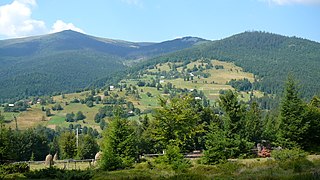
Transylvania is a historical and cultural region in Central-Eastern Europe, encompassing central Romania. To the east and south its natural border is the Carpathian Mountains and to the west the Apuseni Mountains. Broader definitions of Transylvania also include the western and northwestern Romanian regions of Crișana and Maramureș, and occasionally Banat. Historical Transylvania also includes small parts of neighbouring Western Moldavia and even a small part of south-western neighbouring Bukovina to its north east.

Satu Mare County is a county (județ) of Romania, on the border with Hungary and Ukraine. The capital city is Satu Mare.

Satu Mare is a city with a population of 102,400 (2011). It is the capital of Satu Mare County, Romania, as well as the centre of the Satu Mare metropolitan area. It lies in the region of Maramureș, broadly part of Transylvania. Mentioned in the Gesta Hungarorum as castrum Zotmar, the city has a history going back to the Middle Ages. Today, it is an academic, cultural, industrial, and business centre in the Nord-Vest development region.
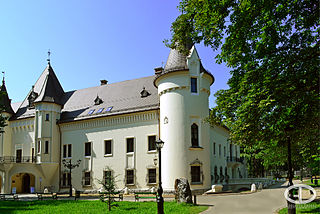
Carei is a city in Satu Mare County, northwestern Romania, near the border with Hungary. The city administers one village, Ianculești.

Dej is a municipality in Transylvania, Romania, 60 kilometres (37 mi) north of Cluj-Napoca, in Cluj County. It lies where the river Someșul Mic meets the river Someșul Mare. The city administers four villages: Ocna Dejului (Désakna), Peștera (Pestes), Pintic (Oláhpéntek) and Șomcutu Mic (Kissomkút).

Fotbal Club Olimpia MCMXXI Satu Mare, commonly known as Olimpia Satu Mare or simply as Olimpia, is a Romanian professional football club from Satu Mare, Satu Mare County, Romania, founded on 5 May 1921, re-founded in 2010 and 2018. The club played in the Liga I in the following seasons: 1937–38, 1974–75, 1975–76, 1977–78, 1978–79, 1979–80 and 1998–99.

The Satu Mare Swabians or Sathmar Swabians are a German ethnic group in the Satu Mare region of Romania. They are one of the few Danube Swabian subgroups that are actually Swabian, and their dialect, Sathmar Swabian, is similar to the other varieties of the Swabian German dialect.

The Romanian government is the armiger in Romania. It exercises this right under the mandatory advice of the National Committee of Heraldry, Genealogy and Sigillography. The committee is subordinate to the Romanian Academy. All the coats of arms of Romanian institutions must be approved by this committee with two exceptions. The Romanian military is subject to the Ministry of National Defense Heraldric Committee, and Romanian law enforcement institutions are subject to the Ministry of Administration and Interior Heraldric Committee. Both of these committees may share members with the National Committee of Heraldry, Genealogy and Sigillography.

Călinești-Oaș is a commune in Satu Mare County, north-western Romania, with a population of 4,686. Part of the region of Maramureș, it is composed of four villages: Călinești-Oaș, Coca (Kakáktelep), Lechința (Avaslekence), and Pășunea Mare (Nagylegelő). Situated on the western side of the Oaș Country Depression at a distance of 46 kilometres (29 mi) from the county capital Satu Mare, Călinești borders Gherța Mică commune to the north, to the south Prilog-Vii village and Livada city, to the east Boinești village and to the west Turulung commune, which represents the boundary of the Oaș Country.

Beltiug is a commune of 3,228 inhabitants situated in Satu Mare County, Transylvania, Romania. It lies on the banks of the Crasna River south of Ardud, 35 km south of the county seat, Satu Mare, along the main road E81. It is today one of the most important cultural centres of the Sathmar Swabian community.

Hodod is a commune of 3,209 inhabitants situated in Satu Mare County, Crișana, Romania. It is composed of four villages:

Arad is the capital city of Arad County, Transylvania. It is the third largest city in Western Romania, behind Timișoara and Oradea, and the 12th largest in Romania, with a population of 159,704.

Clubul Sportiv Sportul 2007 Șimleu Silvaniei, commonly known as Sportul Șimleu Silvaniei, Șimleu Silvaniei or simply as Sportul Șimleu, is a Romanian professional football club based in Șimleu Silvaniei, Sălaj County. The team was founded in 2007, but only one year later entered in a merge with Liga III side Flacăra Halmășd, club which previously cessioned its third tier place from Someşul Satu Mare. The club was renamed as FC Silvania Șimleu Silvaniei and at its best played at the level of Liga II, before it was dissolved in 2011. In the summer of 2011, Sportul Șimleu was re-activated and enrolled in the 5th tier, then in 2012 was enrolled in the 4th tier struggling for years to promote again in the national divisions. Finally, Sportul Șimleu Silvaniei promoted in the Liga III at the end of the 2020–21 season.
Centru Nou is a residential district of Satu Mare in Romania. It was built in the late 1970s and includes the Administrative Palace, one of the tallest buildings in Romania.
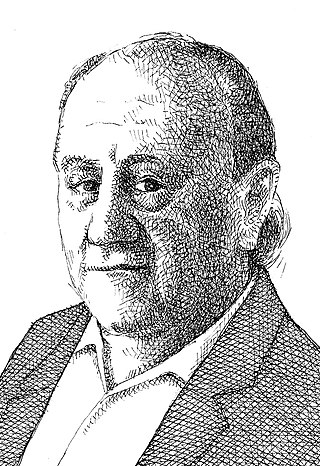
György Harag was a Hungarian director and actor from Transylvania, Romania.
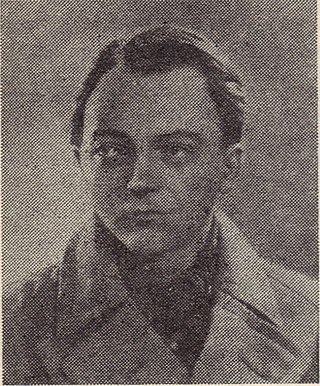
George Mihail Zamfirescu was a Romanian prose writer and playwright.
Amalia Tătăran is a Romanian épée fencer, team silver medallist at the 2013 European Fencing Championships and team gold medallist at the 2015 European Games.
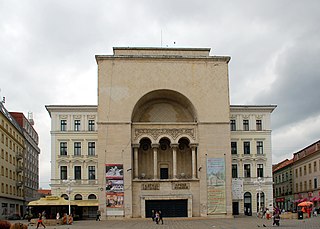
The Palace of Culture is an emblematic building in Timișoara, Romania. It hosts a number of cultural institutions, including the Romanian National Opera, the Mihai Eminescu National Theatre, the Csiky Gergely Hungarian State Theatre and the German State Theatre. On 31 October 1918, the unification of Banat and Romania was agreed upon in the Kronprinz Rudolf restaurant, located on the ground floor, by a group led by Aurel Cosma. On 20 December 1989, during the Romanian Revolution, the Democratic Romanian Front was founded in the Palace of Culture and Timișoara was declared free from communism. The building is a historical monument of national importance, listed under LMI code TM-II-m-A-06118. It occupies the northern side of Victory Square and is one of the main landmarks of the city.

Clubul Sportiv Municipal Victoria Carei, commonly known as Victoria Carei, is a Romanian football club based in Carei, Satu Mare County and currently playing in the Liga III, the third tier of the Romanian football league system, following their promotion from the Liga IV – Satu Mare County in the 2021–22 season. Founded in 1923 Victoria Carei played sixteen seasons in Liga II and thirty-six seasons in Liga III. Their highest league finish is third, in the 1935–36 season of Divizia B.

Club Sportiv Oașul 1969 Negrești-Oaș, commonly known as Oașul Negrești-Oaș or simply as Oașul 1969, is a Romanian amateur football club based in Negrești-Oaș, Romania. The club was founded in 1969, under the name of Energia Negrești-Oaș and in the best period of its history played in the second-tier, for two seasons in a row, between 2003 and 2005. Oașul is currently playing in the Liga IV.



















